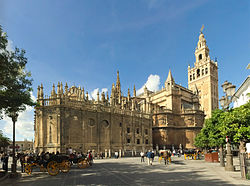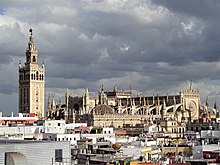Seville Cathedral
| Cathedral, Alcázar and Archivo General de Indias in Seville | |
|---|---|
|
UNESCO world heritage |
|

|
|
| The southeast side of the cathedral |
|
| National territory: |
|
| Type: | Culture |
| Criteria : | i, ii, iii, vi |
| Surface: | 1 ha |
| Reference No .: | 383 |
| UNESCO region : | Europe and North America |
| History of enrollment | |
| Enrollment: | 1987 (session 11) |
The Seville Cathedral ( Catedral de Sevilla ), the Episcopal Church of the Archdiocese of Seville in Seville . It is the largest Gothic church in Spain and one of the largest in the world . It was built 1401-1519, stands since 1928 under monument protection and belongs to since 1987 World Heritage Site of UNESCO .
cathedral
The cathedral was built between 1401 and 1519 in the Gothic style on the remains of the Arab Mezquita Mayor built in the 12th century. It is the largest religious building in Spain and one of the largest cathedrals in the world. Its length together with the royal chapel is 145 m, its width 82 m. The height of the central nave is 42 m, the cathedral has a total of five naves.
In July 2008 the oldest floor plan of the cathedral from the 16th century was found in the Bidaurreta monastery in northern Spain near San Sebastián . The drawing shows five naves and 32 columns.
In addition to magnificent grave sculptures from the Middle Ages, the cathedral also houses the tomb for Christopher Columbus, built in 1902 . The whereabouts of his bones was uncertain after he had crossed the Atlantic several times. The four pallbearers represent the kingdoms of Castile , León , Aragón and Navarre .
Layout
| No. | Surname | Remarks |
|---|---|---|
| 1 | Puerta de la Asuncion | Main entrance; the main portal was not completed until 1833 and shows a stone relief of the " Assumption of the Virgin Mary " in its tympanum |
| 2 | Puerta del Bautismo | The Baptism Portal was built in the 15th century and decorated with a scene of the baptism of Jesus. The work comes from the workshop of Lorenzo Mercadante. It is in the Gothic style. |
| 3 | Puerta del Nacimiento | Portal of Birth |
| 4th | Puerta de San Cristobal | and Porta de la Lonja called |
| 5 | Puerta de las Campanillas | The name comes from the time it was built; from there campanillas (bells) were struck to call the workers. Here is u. a. a relief showing Christ entering Jerusalem. |
| 6th | Puerta de los Palos | or Puerta de la Adoración de los Magos in view of a relief that shows the veneration of the three kings . |
| 7th | Puerta del Lagarto | Lizard gate , a prepared crocodile is hung in front of the entrance |
| 8th | Puerta de la Concepción | The Gate of Conception connects the Cathedral with the Orange Court. It is kept locked and only opened on holidays. It was designed by Demetrio de los Rios and completed by Adolfo Fernandez Casanova. In order to fit into the overall building, it was built in the Gothic style. |
| 9 | Puerta del Sagrario | The gate of the sanctuary, the refuge, connects the main building with the sanctuary. It was designed by Pedro Sanchez Falconete towards the end of the 17th century. It is framed by Corinthian columns. Above him is a statue of King Ferdinand III of Castile next to those of Saints Isidore, Leander, Justa and Rufina. |
| 10 | Puerta del Perdón | Entrance gate from the Moorish times to the orange courtyard of the old mosque. |
| 11 | Capilla Real | forms the "face" of the cathedral: 38 meters long, built between 1551 and 1575 in place of the old royal burial chapel, closed in 1773 with a lattice. |
| 12 | Sala Capitular | Chapter House , built 1530 to 1592. Painting Immaculate Conception by Murillo, c. 1650 to 1670. |
| 13 | Sacristia Mayor | The 16th century building contains valuable art treasures, including the keys of Seville (1248), a reliquary of Alfonso X, a cross relic of St. Helene, a bronze candelabra by Bartolome Morel and the painting " Descent from the Cross " by Pedro de Campana |
| 14th | Sacristia de los Cálices | Sacristy of Chalices, from 1529. Painting by Goya (Saints Justina and Saint Rufina), Luis de Morales (Pieta) and Murillo (Holy Family). |
| 15th | Iglesia del Sagrario | (1618–1662), a beautiful baroque building that houses a retablo bearing a " Descent from the Cross " by Pedro Roldan |
Chapels
The chapel Capilla de San Antonio houses the painting La Visión de San Antonio created by Murillo (visions = the delusions, meaning the temptations of St. Anthony ).
Also worth seeing are the Capilla de la Virgen de la Antigua with the Virgen fresco and the Capilla Real , built in the Renaissance style between 1551 and 1575 . The royal chapel serves as the burial chapel for Ferdinand III. , his wife Beatrix and his sons; including Alfons X.
The Capilla Mayor contains the largest altar retable in the world, the retablo , a major work of Spanish woodcarving Gothic . It was created under several masters between 1482 and 1564 and measures 23 (height) by 20 (width) meters. The image of the Virgen de la Sede , embossed in silver, sits enthroned at the bottom , above 45 magnificent and detailed relief fields with wood-carved scenes from the lives of Jesus Christ and Mary.
organ
The history of the organs in Seville Cathedral can be traced back to 1479. In the course of time there were various instruments. Today there are two large organs in the central nave (choir) . They are mirror images of each other in two bays with the organ prospect to the central nave and the side aisles. Your baroque brochures are made of solid wood.
The instrument, which is played from a central, free-standing console, goes back to the work of Aquelino Amezua from 1901, which was subjected to a neo-baroque transformation in 1970. In 1996 Gerhard Grenzing (El Papiol, Spain) overhauled the organ and restored it to its previous condition. The registers are divided into five works, the main work (organo mayor), the Rückpositiv (“cadireta”, Catalan: “little chair”), the swell work (expresivo), the bombbarden work and the pedal . The register names are based on the tiento .
|
|
|
|
|
|||||||||||||||||||||||||||||||||||||||||||||||||||||||||||||||||||||||||||||||||||||||||||||||||||||||||||||||||||||||||||||||||||||||||||||||||||||||||||||||||||||||||||||||||||||||||||||||||||||||||||||||||||||||||||||||||||||||||||||||||||||||||||||||||||||||||||||||||||
-
Pairing :
- Normal coupling: I / P, II / P, III / P, IV / P, II / I, III / I, IV / I, III / II
- Playing aids : Storage (mixturas ex, llengüeteria ex, exterior ex) fixed combinations (tutti, zapata de expressión para el III), typesetting system
Sarcophagus of Christopher Columbus
The sarcophagus of Christopher Columbus is located at the Puerta de la Lonja . The monument was created in 1902. The sarcophagus is carried by four heralds who represent the kingdoms of Castile , León , Aragon and Navarre . This is a symbolism that the remains of Columbus also “traveled”. After his death in Valladolid in 1506, he was brought to Seville a few years later and then transferred to Santo Domingo in 1596. When the French came there in 1795, they did not want to leave Columbus to them and the remains were brought to Havana. In 1898 the remains were shipped back to Seville. In 2006, Spanish scientists carried out a DNA comparison with the remains from the sarcophagus and remains of Columbus' brother and son Fernando Columbus and confirmed his identity. The fact that the bearers with the coats of arms of Castile and Leon look up, while those with the coats of arms of Navarre and Aragón look down, is supposed to indicate that initially only the former benefited from colonial trade and the other two were excluded from it until 1778.
Giralda
The minaret of the old Moorish mosque , today the tower of the cathedral, called Giralda , is the symbol of the city. The tower is the remainder of the former mosque from 1184 and was then one of the tallest structures in the world (only surpassed by the two largest of the three pyramids in Giza ( Egypt )).
It is unusual that this tower is up to the height of the belfry , i.e. H. up to the gallery at approx. 70 m height, can be climbed on horseback. Instead of stairs, the builders built an approx. 2.50 m wide ramp , the ceiling height of which enables ascent on horseback. Through this ramp (instead of stairs) important news could be announced quickly.
In the bell house there are 24 bells, 20 on the outside - 5 on each side - and 4 bells on the inside. The bronze Giraldillo stands on top of the tower . It is a female statue as an incarnation (embodiment) of the triumphant Christian faith. It is 4 m high, weighs about 2,000 kg and was made by the artist Bartolomé Morel. Today, the Giraldillo, which is located on the Puerta de San Cristobal (Puerta de la Lonja), in front of the cathedral, is a copy of the restored original. There is the tourist entrance for individuals to the cathedral and to visit the Giralda (2017: 9 €; students under 25: 4 €).
Including the extensions carried out in Christian times, with the Giraldillo, the Giralda measures 104.5 meters. The name Giralda (Spanish: girar - turn, circle) comes from the weather vane on the top of the tower.
Orange pit
At the west portal, the Puerta del Perdón , Moorish stylistic features such as Kufic script and horseshoe arch contrast with Christian art. The archway leads to the Orange Courtyard (Patio de los Naranjos). In front of the west facade of the cathedral is the former forecourt of the mosque. The well, which dates back to Visigothic times, was used by the Moors for ritual ablutions.
Web links
Individual evidence
- ↑ "floor plan of the Cathedral of Seville discovered" , Der Standard , July 13, 2008
- ↑ Information about the organs on the cathedral website
- ↑ Information on disposition on the website of the organ builder Grenzing (viewed on November 26, 2018)
- ^ Research thriller: Columbus' grave identified. In: Spiegel Online . May 19, 2006, accessed June 9, 2018 .
- ^ Maria Anna Hälker, Andalusien - Dumont-Reise-Taschenbuch, Ostfildern 2016, page 69
Coordinates: 37 ° 23 ′ 9 ″ N , 5 ° 59 ′ 35 ″ W.












